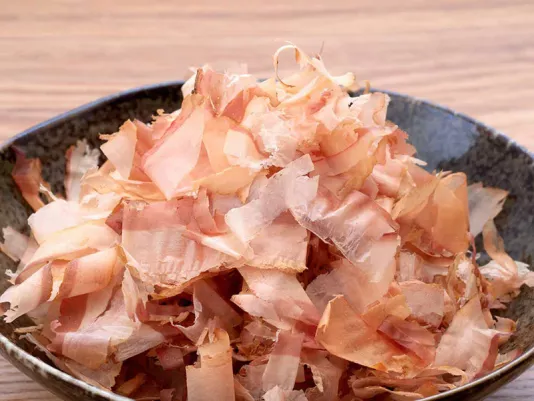Udon Noodles in Soup (Ankake Udon)
Udon noodles in soup (Ankake Udon) – Japanese cuisine recipe, soup keeps warm for a long time due to cornmeal.

Katsuobushi is one of the most important ingredients of Japanese culinary tradition, known far beyond Asia. It is made from bonito tuna, which undergoes a complex process of boiling, smoking, drying, and fermentation, after which it acquires a characteristic hard texture. In its finished form, katsuobushi is shaved into thin, translucent flakes that begin to move when in contact with hot food due to the rising steam, creating a “dancing” effect. These flakes give dishes a deep umami taste and rich aroma, making them an essential part of such key recipes as dashi broth, miso soup, or various sauces. Thanks to its versatility, katsuobushi is widely used today not only in traditional dishes but also in modern gastronomy, where it is combined with meat, vegetables, and even salads to bring a new flavor dimension.
Katsuobushi has a long history that goes back several centuries, when Japanese cooks sought ways to preserve fish for extended periods. Bonito tuna, dried and smoked, became not only a practical means of preservation but also the foundation of a new culinary culture. Thanks to prolonged processing, the product acquires incredible density, allowing it to be stored for years, while shavings from the hardened block give dishes exceptional flavor richness. Katsuobushi is an inseparable part of the concept of “umami,” which has become central in the gastronomic world. Its peculiarity lies in the fact that even a small amount can dramatically change the flavor balance, enhancing the natural aromas of vegetables, meat, or legumes. In many countries, this ingredient is used not only for classic broths but also for creating sauces, marinades, and modern culinary experiments. Katsuobushi symbolizes a bridge between tradition and innovation, as its versatility allows the product to be adapted in various cuisines – from Asian to European.
The process of making katsuobushi is considered one of the most complex among all traditional ingredients. First, bonito tuna is cleaned and boiled in special vats, after which the fillets are smoked for several weeks while gradually drying. The fish then undergoes fermentation, during which its surface is covered with noble mold that helps reduce moisture and enhances aroma. Due to this lengthy processing, the fish meat becomes hard as wood, and amino acids responsible for the umami effect concentrate inside. This makes katsuobushi unique not only in taste but also in nutritional value – it contains proteins, trace elements, and natural antioxidants. Thin flakes quickly release their aroma into liquid, so even a small amount of the ingredient creates a deep broth with a characteristic golden hue. Apart from its culinary function, katsuobushi is also valued for its aesthetic effect: when added to hot dishes, the light shavings move as if alive, creating a magical impression at the table and enhancing the presentation.
Katsuobushi is one of those ingredients that impresses with its versatility. Its most famous use is in making dashi broth, which serves as the base for miso soup, various sauces, and hot dishes. However, the possibilities of this product go far beyond soups. In Japan, it is often used as a topping: for example, katsuobushi is sprinkled on okonomiyaki or takoyaki, where it not only enhances the taste but also creates the effect of a “living” dish thanks to the movement of thin flakes in the hot air. This ingredient also pairs wonderfully with cold dishes – such as soba or udon noodles – where it acts as a light but very aromatic addition. In modern gastronomy, katsuobushi is even added to salads, rice dishes, and vegetable-based appetizers to provide depth of flavor without heavy sauces. Its uniqueness lies in the fact that it can harmoniously complement both delicate and intense ingredients, not overpowering their natural aroma but instead enhancing the balance of flavors.
Katsuobushi has the rare ability to intensify the taste of almost any dish without altering its main character. It pairs most harmoniously with soy sauce and kombu seaweed, forming the base of dashi broth, which is considered the heart of Japanese cuisine. But tuna flakes are also successfully added to vegetable dishes: they are sprinkled on spinach, eggplants, or daikon to highlight their texture and delicate taste. In global gastronomy, katsuobushi is increasingly combined with meat and poultry, as it adds depth to sauces, marinades, and even grilled dishes. Surprisingly good results come from its pairing with dairy products: chefs experiment by adding tuna flakes to creamy sauces or even cheese, creating new culinary accents. Its role in modern fusion recipes is also worth noting: katsuobushi is used in pasta, salads, and even pizza, where it enhances flavor without the need for large amounts of spices. Such versatility has made it a sought-after ingredient for chefs worldwide.
Today, katsuobushi has long gone beyond traditional Japanese cuisine and has become a valued ingredient in many countries. It is used in fine dining restaurants to create complex flavor combinations, as well as in home cooking as a simple way to enrich dishes with deep aroma. Chefs add tuna flakes to soups, sauces, side dishes, and even desserts, experimenting with new flavor pairings. Katsuobushi has become especially popular in fusion cuisine, where different gastronomic traditions come together: it can be found in dishes with Italian pasta, Mediterranean-style salads, or even combined with products typical of American cuisine. This ingredient also attracts culinary professionals because it is easy to store, retains its flavor qualities for a long time, and allows any dish to quickly gain depth. Katsuobushi has become a symbol of culinary globalization: it demonstrates how a traditional product can find its place in the most diverse contexts, enriching the culinary world with new shades of umami.